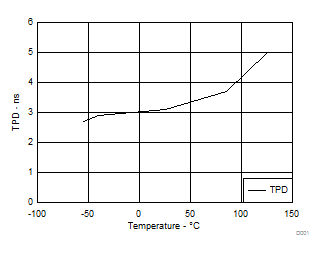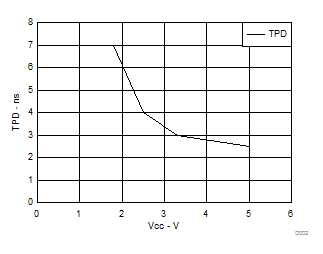SCES193N April 1999 – January 2015 SN74LVC2G00
PRODUCTION DATA.
- 1 Features
- 2 Applications
- 3 Description
- 4 Simplified Schematic
- 5 Revision History
- 6 Pin Configuration and Functions
- 7 Specifications
- 8 Parameter Measurement Information
- 9 Detailed Description
- 10Application and Implementation
- 11Power Supply Recommendations
- 12Layout
- 13Device and Documentation Support
- 14Mechanical, Packaging, and Orderable Information
封装选项
请参考 PDF 数据表获取器件具体的封装图。
机械数据 (封装 | 引脚)
- DCU|8
- YZP|8
- DCT|8
散热焊盘机械数据 (封装 | 引脚)
订购信息
7 Specifications
7.1 Absolute Maximum Ratings
over operating free-air temperature range (unless otherwise noted)(1)| MIN | MAX | UNIT | |||
|---|---|---|---|---|---|
| VCC | Supply voltage range | –0.5 | 6.5 | V | |
| VI | Input voltage range(2) | –0.5 | 6.5 | V | |
| VO | Voltage range applied to any output in the high-impedance or power-off state(2) | –0.5 | 6.5 | V | |
| VO | Voltage range applied to any output in the high or low state(2)(3) | –0.5 | VCC + 0.5 | V | |
| IIK | Input clamp current | VI < 0 | –50 | mA | |
| IOK | Output clamp current | VO < 0 | –50 | mA | |
| IO | Continuous output current | ±50 | mA | ||
| Continuous current through VCC or GND | ±100 | mA | |||
| Tstg | Storage temperature range | –65 | 150 | °C | |
(1) Stresses beyond those listed under Absolute Maximum Ratings may cause permanent damage to the device. These are stress ratings only, and functional operation of the device at these or any other conditions beyond those indicated under Recommended Operating Conditions is not implied. Exposure to absolute-maximum-rated conditions for extended periods may affect device reliability.
(2) The input negative-voltage and output voltage ratings may be exceeded if the input and output clamp-current ratings are observed.
(3) The value of VCC is provided in the Recommended Operating Conditions table.
7.2 ESD Ratings
| VALUE | UNIT | |||
|---|---|---|---|---|
| V(ESD) | Electrostatic discharge | Human body model (HBM), per ANSI/ESDA/JEDEC JS-001, all pins(1) | 2000 | V |
| Charged device model (CDM), per JEDEC specification JESD22-C101, all pins(2) | 1000 | |||
(1) JEDEC document JEP155 states that 500-V HBM allows safe manufacturing with a standard ESD control process.
(2) JEDEC document JEP157 states that 250-V CDM allows safe manufacturing with a standard ESD control process.
Recommended Operating Conditions
(1)| MIN | MAX | UNIT | |||
|---|---|---|---|---|---|
| VCC | Supply voltage | Operating | 1.65 | 5.5 | V |
| Data retention only | 1.5 | ||||
| VIH | High-level input voltage | VCC = 1.65 V to 1.95 V | 0.65 × VCC | V | |
| VCC = 2.3 V to 2.7 V | 1.7 | ||||
| VCC = 3 V to 3.6 V | 2 | ||||
| VCC = 4.5 V to 5.5 V | 0.7 × VCC | ||||
| VIL | Low-level input voltage | VCC = 1.65 V to 1.95 V | 0.35 × VCC | V | |
| VCC = 2.3 V to 2.7 V | 0.7 | ||||
| VCC = 3 V to 3.6 V | 0.8 | ||||
| VCC = 4.5 V to 5.5 V | 0.3 × VCC | ||||
| VI | Input voltage | 0 | 5.5 | V | |
| VO | Output voltage | 0 | VCC | V | |
| IOH | High-level output current | VCC = 1.65 V | –4 | mA | |
| VCC = 2.3 V | –8 | ||||
| VCC = 3 V | –16 | ||||
| –24 | |||||
| VCC = 4.5 V | –32 | ||||
| IOL | Low-level output current | VCC = 1.65 V | 4 | mA | |
| VCC = 2.3 V | 8 | ||||
| VCC = 3 V | 16 | ||||
| 24 | |||||
| VCC = 4.5 V | 32 | ||||
| Δt/Δv | Input transition rise or fall rate | VCC = 1.8 V ± 0.15 V, 2.5 V ± 0.2 V | 20 | ns/V | |
| VCC = 3.3 V ± 0.3 V | 10 | ||||
| VCC = 5 V ± 0.5 V | 5 | ||||
| TA | Operating free-air temperature | –40 | 125 | °C | |
(1) All unused inputs of the device must be held at VCC or GND to ensure proper device operation. Refer to the TI application report, Implications of Slow or Floating CMOS Inputs, literature number SCBA004.
7.3 Thermal Information
| THERMAL METRIC(1) | SN74LVC1G00 | UNIT | |||
|---|---|---|---|---|---|
| DCT | DCU | YZP | |||
| 5 PINS | 5 PINS | 5 PINS | |||
| RθJA | Junction-to-ambient thermal resistance | 220 | 227 | 102 | °C/W |
(1) For more information about traditional and new thermal metrics, see the IC Package Thermal Metrics application report, SPRA953.
Electrical Characteristics
over recommended operating free-air temperature range (unless otherwise noted)| PARAMETER | TEST CONDITIONS | VCC | –40°C to 85°C | –40°C to 125°C | UNIT | ||||||
|---|---|---|---|---|---|---|---|---|---|---|---|
| MIN | TYP(1) | MAX | MIN | TYP(1) | MAX | ||||||
| VOH | IOH = –100 μA | 1.65 V to 5.5 V | VCC – 0.1 | VCC – 0.1 | V | ||||||
| IOH = –4 mA | 1.65 V | 1.2 | 1.2 | ||||||||
| IOH = –8 mA | 2.3 V | 1.9 | 1.9 | ||||||||
| IOH = –16 mA | 3 V | 2.4 | 2.4 | ||||||||
| IOH = –24 mA | 2.3 | 2.3 | |||||||||
| IOH = –32 mA | 4.5 V | 3.8 | 3.8 | ||||||||
| VOL | IOL = 100 μA | 1.65 V to 5.5 V | 0.1 | 0.1 | V | ||||||
| IOL = 4 mA | 1.65 V | 0.45 | 0.45 | ||||||||
| IOL = 8 mA | 2.3 V | 0.3 | 0.3 | ||||||||
| IOL = 16 mA | 3 V | 0.4 | 0.4 | ||||||||
| IOL = 24 mA | 0.55 | 0.55 | |||||||||
| IOL = 32 mA | 4.5 V | 0.55 | 0.55 | ||||||||
| II | A or B inputs | VI = 5.5 V or GND | 0 to 5.5 V | ±5 | ±5 | μA | |||||
| Ioff | VI or VO = 5.5 V | 0 | ±10 | ±10 | μA | ||||||
| ICC | VI = 5.5 V or GND, | IO = 0 | 1.65 V to 5.5 V | 10 | 10 | μA | |||||
| ΔICC | One input at VCC – 0.6 V, Other inputs at VCC or GND |
3 V to 5.5 V | 500 | 500 | μA | ||||||
| CI | VI = VCC or GND | 3.3 V | 5 | pF | |||||||
(1) All typical values are at VCC = 3.3 V, TA = 25°C.
Electrical Characteristics (Continued)
TA = 25°C| PARAMETER | TEST CONDITIONS | VCC = 1.8 V | VCC = 2.5 V | VCC = 3.3 V | VCC = 5 V | UNIT | |
|---|---|---|---|---|---|---|---|
| TYP | TYP | TYP | TYP | ||||
| Cpd | Power dissipation capacitance | f = 10 MHz | 19 | 19 | 20 | 22 | pF |
Switching Characteristics, -40°C to 85°C
over recommended operating free-air temperature range (unless otherwise noted) (see Figure 3)| PARAMETER | FROM (INPUT) |
TO (OUTPUT) |
–40°C to 85°C | UNIT | |||||||
|---|---|---|---|---|---|---|---|---|---|---|---|
| VCC = 1.8 V ± 0.15 V |
VCC = 2.5 V ± 0.2 V |
VCC = 3.3 V ± 0.3 V |
VCC = 5 V ± 0.5 V |
||||||||
| MIN | MAX | MIN | MAX | MIN | MAX | MIN | MAX | ||||
| tpd | A or B | Y | 3.7 | 8.6 | 1.6 | 4.8 | 1.1 | 4.3 | 1 | 3.3 | ns |
7.4 Switching Characteristics, -40°C to 125°C
over recommended operating free-air temperature range (unless otherwise noted) (see Figure 3)| PARAMETER | FROM (INPUT) |
TO (OUTPUT) |
–40°C to 125°C | UNIT | |||||||
|---|---|---|---|---|---|---|---|---|---|---|---|
| VCC = 1.8 V ± 0.15 V |
VCC = 2.5 V ± 0.2 V |
VCC = 3.3 V ± 0.3 V |
VCC = 5 V ± 0.5 V |
||||||||
| MIN | MAX | MIN | MAX | MIN | MAX | MIN | MAX | ||||
| tpd | A or B | Y | 3.7 | 9.4 | 1.6 | 5.5 | 1.1 | 4.9 | 1 | 3.8 | ns |
7.5 Typical Characteristics
 Figure 1. TPD vs Temperature at 3.3-V VCC
Figure 1. TPD vs Temperature at 3.3-V VCC
 Figure 2. TPD vs VCC at 25°C
Figure 2. TPD vs VCC at 25°C